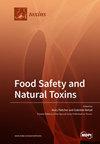将多种全息技术与分子动力学相结合,揭示黄曲霉毒素 B1 在 SW480 细胞中由 SCP2 介导的细胞毒性效应
IF 3.9
3区 医学
Q2 FOOD SCIENCE & TECHNOLOGY
引用次数: 0
摘要
黄曲霉毒素属于霉菌毒素的一种,其中黄曲霉毒素 B1(AFB1)对动物和人类的健康都有不利影响。长期接触会引起致癌、肝中毒、肾中毒、神经中毒和免疫抑制,导致多种疾病。肠道是人类暴露于 AFB1 的第一道屏障,但目前为阐明肠道细胞毒性的基本机制而进行的研究十分有限。本研究采用转录组、蛋白质组和代谢组分析与分子动力学模拟相结合的综合方法研究了 AFB1 诱导细胞毒性的机制。将 SW480 细胞暴露于 50 μM AFB1 72 小时后,转录组、蛋白质组和代谢组中与氧化应激、脂肪酸和脂质代谢以及谷胱甘肽代谢相关的通路出现了显著的富集。实验结果表明,AFB1 能显著降低 SW480 细胞的活力,并诱导氧化应激、钙超载、线粒体损伤和脂质代谢紊乱。本文章由计算机程序翻译,如有差异,请以英文原文为准。
Combining Multiple Omics with Molecular Dynamics Reveals SCP2-Mediated Cytotoxicity Effects of Aflatoxin B1 in SW480 Cells
Aflatoxins belong to a class of mycotoxins, among which aflatoxin B1 (AFB1) has detrimental effects on the health of both animals and humans. It is associated with long-term exposure-induced carcinogenicity, hepatotoxicity, renal toxicity, neurotoxicity, and immunosuppressive properties, resulting in a variety of diseases. The intestine is the first barrier for human exposure to AFB1, but limited investigations have been conducted to clarify the underlying mechanisms of intestinal cytotoxicity. The mechanism of AFB1-induced cytotoxicity was investigated in this study using an integrated approach combining transcriptome, proteome, and metabolome analysis along with molecular dynamics simulation. After exposing SW480 cells to 50 μM AFB1 for 72 h, the transcriptome, proteome, and metabolome exhibited significant enrichment in pathways associated with oxidative stress, fatty acid and lipid metabolism, and glutathione metabolism. The experimental results demonstrated that AFB1 significantly reduces SW480 cells viability, and induces oxidative stress, calcium overload, mitochondrial damage, and lipid metabolism disorders.
求助全文
通过发布文献求助,成功后即可免费获取论文全文。
去求助
来源期刊

Toxins
TOXICOLOGY-
CiteScore
7.50
自引率
16.70%
发文量
765
审稿时长
16.24 days
期刊介绍:
Toxins (ISSN 2072-6651) is an international, peer-reviewed open access journal which provides an advanced forum for studies related to toxins and toxinology. It publishes reviews, regular research papers and short communications. Our aim is to encourage scientists to publish their experimental and theoretical results in as much detail as possible. There is no restriction on the length of the papers. The full experimental details must be provided so that the results can be reproduced.
 求助内容:
求助内容: 应助结果提醒方式:
应助结果提醒方式:


